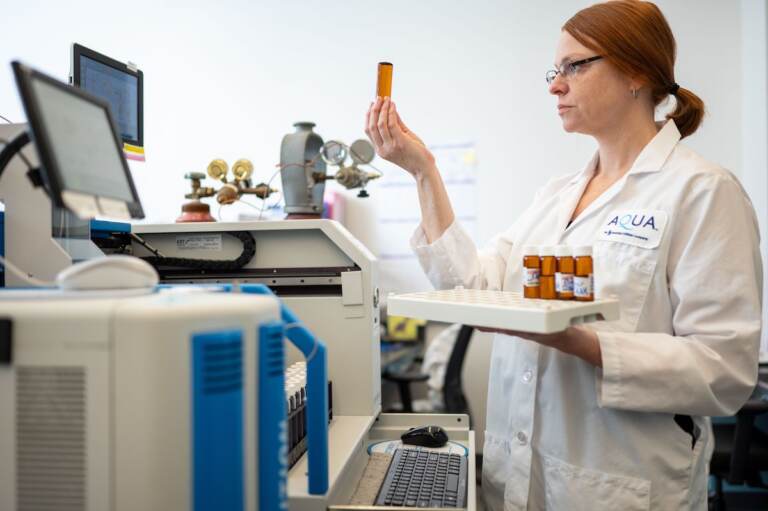Philly officials say the water is safe. How do we know that?
More than 100 samples of water have been taken in 12 locations in the river, outside the plant, and in the raw water storage basin.

Aqua Lab Director Alicia Beauchamp tests water samples from the March 25 Delaware River chemical spill at the company’s Bryn Mawr headquarters. (Courtesy of Aqua Water)
On Tuesday evening, the city of Philadelphia gave its residents the all clear to drink their tap water, after more than an estimated 8,000 gallons of a water-based latex finishing solution spilled from the Trinseo Altuglas plant in Bristol, Pa. into the Delaware River late Friday night.
Much of the chemical mixture settled in a containment pond, but rainfall contributed to the milky white liquid spilling into the stormwater system, and eventually the Delaware River. By early Sunday evening, the discharge had halted. Clean up continues at the site, but any danger to drinking water systems has passed.
WHYY spoke to a number of experts to find out how these spills are handled, how the water is tested, and why it’s safe to drink.
What chemicals were spilled into the Delaware River?
The chemicals included:
- butyl acrylate: a clear, flammable liquid used in the manufacture of resins, sealants and paint formulations. It’s one of the chemicals that was released during the East Palestine, Ohio. train derailment.
- ethyl acrylate: a colorless liquid used in the production of acrylic resins, water-based latex paints, plastics, and rubber.
- methyl methacrylate: a colorless flammable liquid used to make plastics, resins, paints, and coatings.
The federal government does not enforce limits on or regulate these chemicals in drinking water, so they’re not regularly tested for — neither are they commonly found in water supplies. That made it more challenging for water utilities to quickly test for them.
Trinseo, the company responsible for the spill, only provided the brand name of the product for the first 13 hours of the spill, according to the Philadelphia Water Department, making it impossible to test for specific chemicals at that time. The chemical components were not provided until about 1:30 p.m. on Saturday.
How was contamination prevented in Philadelphia?
The Baxter water treatment plant is the only one of the city’s three plants connected to water from the Delaware River. The Philadelphia Water Department shut intakes to the Baxter water treatment plant as a precaution. The plant had stored enough clean water prior to the spill that it could send to residents’ taps.
How was the water monitored?
More than a hundred samples of water have been taken in 12 locations in the river, outside the plant, and in the raw water storage basin.
Scientists used gas chromatography and mass spectrometry to test for the chemicals. This is an analytical technique that allows scientists to separate components of a complex mixture — such as the various components in water — and analyze them to get information about the structure of those components, and how much of it is present.
The standard technique has been around for about 50 years, and is commonly used for trace analysis of environmental water samples.
Environmental analytical chemist Chuck Powley of PFAS Solutions in Delaware said the technology is very reliable, and that the three chemicals of concern are compatible with this technique.
“These are very common chemicals. They’ve been around for quite a while, and there are standard EPA methods for analyzing them in water,” he said.
The method can detect chemicals to single parts per billion.
“You can think of that in terms of, if you have a billion dollars, and you gave someone $1, the amount that person has is one part per billion,” said Jon Scaffidi, an administrative scientist at the Philadelphia Water Department’s Bureau of Laboratory Services, during a press conference Tuesday.
Following the Friday chemical spill, Aqua, which supplies water to eight states and has a site in Bristol, tested samples day and night for 63 kinds of chemicals.
The company was already prepared to test for butyl acrylate, because it serves water in Ohio, where the train derailment took place. Even though Aqua doesn’t regularly test for the other two chemicals, it had the technology in place to do so, said Christopher Crockett, vice president and chief environmental, safety, & sustainability officer of essential utilities.
It’s a complicated process, however.
“Most people think this testing is like the CSI Miami montage, where you go and they play a song, and next thing you know, they have all the test results back,” Crockett said. “But, you have to process it, set it up, and then it takes about an hour to run … you’re taking a couple dozen or so samples at a time … And basically you’re waiting for the machine to run to get the results.”
Scientists also must review the data to make sure no errors were made.
The Philadelphia Water Department also utilized three additional private labs to help with testing, a spokesperson for the department said.
“This was important to maximize turn-around time of results,” he said in an email. “Finding specialized labs that can test for these chemicals at the parts-per-billion level absolutely added to the challenges of the spill response.”
Computer modeling also predicted the path of the spill and how long the chemical compound would take to work its way down the Delaware River. Crockett likens it to dumping a bunch of rubber ducks in the water.
“It would basically simulate how those rubber ducks would move down through the Delaware River, and when those rubber ducks would get to different places and where they were going,” he said.
Because the Delaware River is tidal, the path is a bit tricky.
“When you dump the ducks in, they might go downstream 10 miles, but then they might come back up 8 miles with the tide,” he said. “After 24 hours, they’ve only moved 2 miles downstream, net. So it’s kind of like three steps forward, one step back. The computer basically simulates exactly that sloshing back and forth, and how long it will take for something to move its way down through there.”
What do tests finally show?
The three chemicals were never found in the water. Testing in the river demonstrated that as the contaminated water diluted and traveled down the river, the risk to the drinking water system passed. There is no longer the possibility of the chemicals entering the Baxter plant.
Crockett said the city was prepared to handle the situation because of what he likes to call “utility first responders.”
“There are utility workers in the water industry that are constantly dealing with these issues so that [residents] don’t have to think about it. So it doesn’t have to become, ‘Should I buy bottled water or not?’” he said. “There are probably a dozen or more of these types of events every year in the Delaware Valley … We have systems like the early warning system,and we have [standard operating procedures] … that we drill for like this so that when these things happen, everything works like it should have.”
Was Philadelphia the only water system threatened by the spill?
No. Aqua Water has a plant in Bristol, but the company shut down the intake. Aqua recently reopened after ensuring no contaminants entered its system. New Jersey American Water has a plant in Delran, and they too reported that their testing showed no presence of the contaminants. Burlington, N.J. also has a plant right across the river from the spill site.
What agencies participated in responding to the spill?
The U.S. Coast Guard is the lead federal agency responding to the spill. Others include the EPA, the Pennsylvania Department of Environmental Protection, the New Jersey Department of Environmental Protection, and the Pennsylvania Fish and Boat Commission.

Get daily updates from WHYY News!
WHYY is your source for fact-based, in-depth journalism and information. As a nonprofit organization, we rely on financial support from readers like you. Please give today.







